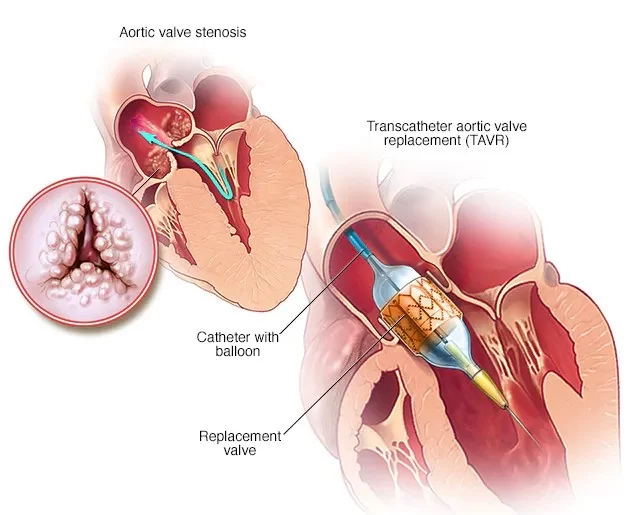
Transcatheter Aortic Valve Implantation (TAVI), also known as Transcatheter Aortic Valve Replacement (TAVR), is a minimally invasive procedure used to treat patients with aortic stenosis, a condition where the aortic valve becomes narrowed and obstructs blood flow from the heart to the rest of the body. The procedure involves implanting a new valve into the heart without the need for traditional open-heart surgery.
Overview of Aortic Stenosis:
- Aortic stenosis occurs when the aortic valve (which controls blood flow from the left ventricle into the aorta) becomes thickened or calcified, restricting the blood flow.
- Symptoms can include chest pain, shortness of breath, fatigue, and fainting. Over time, severe aortic stenosis can lead to heart failure or sudden death if not treated.
What is TAVI?
TAVI is a less invasive alternative to traditional aortic valve replacement (AVR), which typically requires open-heart surgery. In TAVI, a new valve is delivered to the heart via a catheter (a thin flexible tube) inserted through a blood vessel, often in the groin or chest, and then implanted within the diseased valve.
Key Steps in the TAVI Procedure:
- Accessing the Heart:
- The procedure is usually performed under local anesthesia and conscious sedation, though general anesthesia may be used in some cases.
- The catheter is typically inserted through the femoral artery in the groin, but in some cases, access may be obtained via other arteries, such as the subclavian artery (under the collarbone) or through a small incision in the chest (transapical approach).
- Valve Delivery:
- The catheter is guided through the blood vessels to the heart. Once in position, a balloon is inflated to push aside the diseased valve and make room for the new one.
- A new valve, usually made from biological tissue (either bovine or porcine), is mounted on a metal stent and is carefully deployed within the old valve, allowing it to open and restore normal blood flow.
- Post-Procedure Care:
- After the valve is implanted, the catheter is removed, and the access site is closed.
- Patients are closely monitored for complications, and they may need to stay in the hospital for a few days before being discharged.
Types of TAVI Approaches:
- Transfemoral (via the femoral artery): This is the most common approach, where the catheter is inserted through the groin.
- Transapical (via the chest wall): If femoral access is not possible due to narrowed arteries or other issues, the catheter may be inserted through a small incision in the chest.
- Transaortic (via the aorta): This approach involves accessing the heart through an incision in the upper chest, directly in the aorta.
Advantages of TAVI:
- Minimally invasive: TAVI avoids the need for open-heart surgery, reducing recovery time, pain, and risk of infection.
- Faster recovery: Most patients can go home within a few days after the procedure and resume normal activities within weeks, as opposed to the months it might take after traditional surgery.
- Better option for high-risk patients: TAVI is particularly beneficial for older adults or patients who are considered high-risk for traditional surgery due to age, frailty, or other health conditions.
- Improved outcomes: Studies have shown that TAVI can improve survival and quality of life in patients with severe aortic stenosis, especially those who are too frail for open surgery.
Risks and Potential Complications:
- Vascular complications: Damage to the arteries through which the catheter is inserted (e.g., the femoral artery) can occur, though this is relatively rare.
- Stroke: A small risk of stroke exists due to the possibility of plaque or blood clots dislodging during the procedure.
- Paravalvular leak: Sometimes, the new valve does not completely seal against the old valve, leading to a leak, though this can often be managed.
- Infection: Like any medical procedure, there is a risk of infection at the catheter insertion site.
- Heart rhythm issues: Some patients may experience irregular heart rhythms (arrhythmias) after the procedure.
Indications for TAVI:
TAVI is typically recommended for patients who:
- Have severe aortic stenosis causing symptoms or impairing heart function.
- Are not candidates for open heart surgery due to age, frailty, or other medical conditions.
- Are at intermediate to high risk for surgical complications or mortality.
- Can benefit from a valve replacement to improve their symptoms and quality of life.
Post-TAVI Care:
- Patients typically require lifelong anticoagulation therapy (blood thinners) to prevent blood clots from forming on the new valve.
- Regular follow-up visits are essential to monitor the valve’s function, the patient’s recovery, and the heart’s overall health.
- Most patients experience significant improvement in symptoms, with enhanced ability to engage in physical activity and an overall better quality of life.



